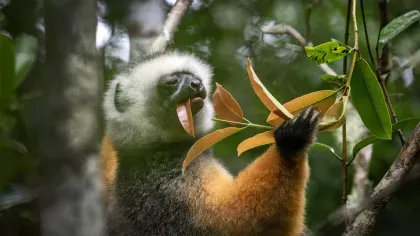6 November 2016
Painting Kew's heritage trees
Kew artist Masumi Yamanaka has spent five years painting Kew’s heritage and champion trees.

Kew artist Masumi Yamanaka has been working at the Gardens since 2006 but her interest in Kew's trees began when she painted the Indian horse chestnut, Aesculus indica ‘Sydney Pearce’ in 2010. She was awarded a Royal Horticultural Society (RHS) Gold Medal of Botanical Art, and Masumi was inspired to begin looking closely at Kew’s 14,000 trees, in particular the 13 ‘heritage’ trees at Kew.
History of the living collections at Kew
Many trees have been added to Kew’s living collections over the last 250 years. The collections began with Charles Bridgeman landscaping Queen Caroline’s Richmond Gardens, followed by Lord Bute expanding the arboretum for Prince Frederick and Princess Augusta in 1762. Later, there is evidence that 177 trees were planted in 1773 by ‘Capability’ Brown. In 1850, Sir William Hooker regrouped and defined the trees into taxonomic clusters and new vistas which totalled 2325 species and 1156 varieties, while in 1871, Joseph Hooker planted 1200 conifers in a new pinetum. Many trees have been planted by members of the Royal Family over the last 100 years, and a ten-year planting programme began in 2004 with mature trees being added to Pagoda Vista.

A record of Kew's trees
Masumi’s paintings act as a record of a small part of the living tree collection at Kew. The Japanese pagoda tree painted by Masumi is the specimen planted in 1762 under the direction of William Aiton and Princess Augusta. It was one of five specimens that arrived in England in 1753, and today, as shown in Masumi’s painting, the tree is growing horizontally while supported by metal straps and props.
Another tree featured in the exhibition, the black locust tree, Robinia pseudoacacia, was also planted in 1762 to form part of Princess Augusta’s arboretum. One of the highlights of the show is the biggest tree at Kew, in terms of volume - the chestnut leaved oak, Quercus castaneifolia. Kew’s specimen is the largest of its kind in Britain and in 2007 it measured 34 meters high with a trunk of 6.9 meters in diameter. This was likely to have been planted by Sir William Hooker in 1846.
The history of the living collections in Kew's Library, Art and Archives
These trees are a part of Kew’s vast history, well-documented in Kew’s Library, Art and Archives, and there are significant items from Kew's records included in the exhibition. Alongside books such as John Evelyn’s Silva, A Discourse of Forest Trees, and The Propagation of Timber in his Majesty’s Dominions, published in 1662, there are archive photographs, including one of the Temple of the Sun built in 1761 by Sir William Chambers.
The photo shows the temple alongside a cedar of Lebanon, Cedrus libani, which collapsed upon the building during a storm in 1916; another photo in the collection shows the damage that was done. More history is evident in the painting of the stone pine, Pinus pinea, which has lost trunks due to adverse weather since the tree was immortalised.
To build Kew’s collections and continue recording the history of Kew’s trees, Masumi’s paintings are available for sponsorship.
Get in touch to find out how you might be able to support botanic artists at Kew and some of our other work.


